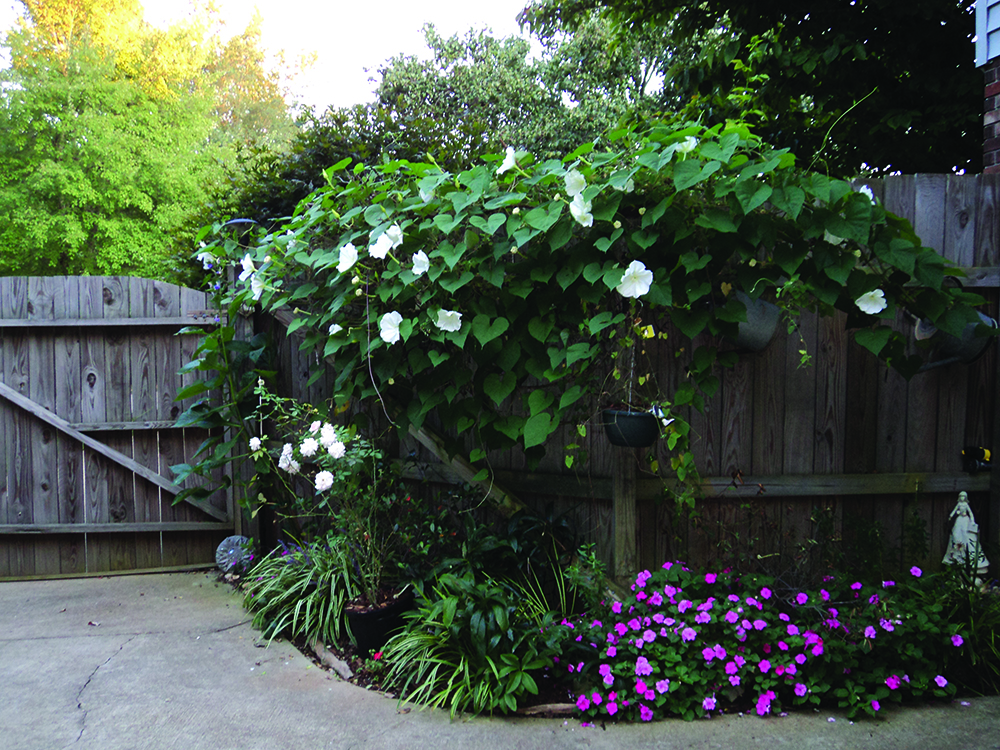lot of time gardening. I’m sure you have as well. I’ve discovered during our recent time of being home a lot more that I would rather be outside in the garden all the time than inside cleaning and doing the laundry at any time! And it is amazing how the quantity of time is in direct proportion with the quality of my nature findings. To give you an example, one morning last week while walking in the garden, I noticed a large object on the ground. To my surprise it was an Antheraea Polyphemus, polyphemus moth or giant silk moth one of the largest in North America with a wingspan up to seven inches. It was fresh from its cocoon taking a moment to dry its wings before its maiden flight. I was so excited to see it especially since I had just seen a Luna moth a couple of days prior…another giant silk moth. On this early morning walk, I could smell the sweet fragrance of the Moonflower that still had a few of its large white flowers open while waiting for the sun to come over the tops of the trees.
That sweet scent of the Moonflower is one of the reasons why I have been growing Ipomoea alba ‘Moonflower Vine’ for many years. It is native to Central America and is often found climbing the trunks of the Panama Rubber Tree and was introduced to American gardens during the 1700s. It is cousin to the sweet potato vine and morning glories but blooms at night not in the mornings. It is a fast-growing vine with stems that grow 10 to 15 feet tall. The sweet fragrance reminds me of the magnolia blossoms and is extremely attractive to night creatures like moths that visit to gather nectar and pollinate flowers. Now, I know the giant silk moths never feed… they just reproduce. But the first time I saw the Macroglossum stellatarum, hummingbird hawkmoth with its long proboscis feeding one evening on one of the blossoms, I thought it was some prehistoric hummingbird! I was so fascinated with this moth, that this is another reason for growing the Moonflower.
The large, pure white flowers are 6 inches or more in diameter and stay open just one night. As the morning sun hits the flower, it will close and wither. On cloudy days, you get a few extra hours before the droop. It’s best to grow this flower on a fence like I do at WillowDale or some large trellis for the vines can reach up to 20 feet in a long, hot growing season. I do a lot of pinching off the growing tips to keep it within bounds. The stems ‘bleed’ when you cut them so it’s important to wash your hands if you get sap on them as the seeds and most parts of the plant are toxic.
This amazon vine starts to open in mid to late July depending on how hot it is and continues throughout the fall with many fragrant moonflowers until the first frost. I have never found the plants at any nursery, but I have found them occasionally at a flea market where someone has started them from seeds to sell. You can buy seed packets and once you do that, you can gather the ripe seeds from your own vines to save for next year. But if you save them, be sure to gather a few more than you think you’ll need just in case they don’t germinate. The seeds are about the size of a pea and have a hard coating that needs to be broken before they can sprout. It’s best to nick the seed and soak overnight in warm water. It is a tropical plant that grows as an annual in our area so make sure the temperature is consistently hitting 70 degrees. Plant one half inch deep in a well-drained, sunny location. Give it plenty of support for once it germinates, it grows very quickly soon giving you the sweet smell of Moonflowers.
The Moonflower is a fleeting beauty blooming only at night and gone by morning. But when the evening comes each new bud magically opens in just one minute and releases a sweet fragrance all night long as it beckons the night creatures one more time. That scent, its beauty, and the night creatures…three exceptionally good reasons to grow Moonflowers!■



